Expansion of Treeline in North China and Its Relationship with Altitude Sensitivity Gradient of Larix gmelinii
Abstract
:1. Introduction
2. Materials and Methods
2.1. General Description of the Study Area
2.2. Materials and Methods
2.2.1. Sample Collection
2.2.2. Meteorological Data
2.2.3. Data Analysis Methods
3. Results
3.1. Dynamics of Treeline Movement on Dabai Mountain
3.2. Comparison of Radial Growth at Different Altitudes
3.3. Comparison of Climate Responses of Trees at Different Altitudes
3.4. Stability of Tree Growth Response to Climate at Different Altitudes
4. Discussion
4.1. Characterization of the Temporal and Spatial Gradient of Larix gmelinii in Response to Climatic Factors
4.2. Relationship between Tree Response Divergence and Treeline Rise
5. Conclusions
- The subtimberline forest on Dabai Mountain regenerated around 1940 and the treeline moved upward around 1970; these two expansion time points roughly coincide with the period of global warming.
- The radial growth of trees varied by altitude with increasing temperatures, showing little change at the treeline, an increase in the treeline ecotone, and “growth divergence” in the subtimberline forest. The divergence was due to a change in response to the previous year’s October maximum temperature during the rapid warming period that began in the mid-1980s.
- Trees at different elevations also had different sensitivities to climate: as elevation decreased, the sensitivity of the annual radial growth to the previous and current years’ growing seasons maximum temperatures changed from positive to negative, with warming promoting the growth of trees at higher elevations and limiting the growth of trees at lower elevations.
- Rapid warming influenced the stability of trees’ response to some climate indicators at different altitudes. The relationship between growth and the previous year’s fall temperature shifted from negative or no correlation to a positive correlation at the treeline and treeline ecotone, but in the subtimberline forest, the previous correlation disappeared. Thus, we find that warming enhances the “legacy effect” at higher altitudes but reduces it at lower altitudes.
- The stability of the influence of different climate indicators on tree growth varies by altitude and shows changes developing through the warming period. We find evidence that there is an inverted “U” relationship between radial growth and some climate conditions.
Author Contributions
Funding
Data Availability Statement
Acknowledgments
Conflicts of Interest
References
- Parmesan, C.; Yohe, G. A globally coherent fingerprint of climate change impacts across natural systems. Nature 2003, 421, 37–42. [Google Scholar] [CrossRef]
- Walther, G.R.; Post, E.; Convey, P.; Menzel, A.; Parmesan, C.; Beebee, T.J.; Fromentin, J.M.; Hoegh-Guldberg, O.; Bairlein, F. Ecological responses to recent climate change. Nature 2002, 416, 389–395. [Google Scholar] [CrossRef]
- Root, T.L.; Price, J.T.; Hall, K.R.; Schneider, S.H.; Rosenzweig, C.; Pounds, J.A. Fingerprints of global warming on wild animals and plants. Nature 2003, 421, 57–60. [Google Scholar] [CrossRef]
- Astrup, R.; Bernier, Y.P.; Genet, H.; Lutz, D.A.; Bright, R.M. A sensible climate solution for the boreal forest. Nat. Clim. Chang. 2018, 8, 11–12. [Google Scholar] [CrossRef]
- Gauthier, S.; Bernier, P.; Kuuluvainen, T.; Shvidenko, A.Z.; Schepaschenko, D.G. Boreal forest health and global change. Science 2015, 349, 819–822. [Google Scholar] [CrossRef]
- Bradshaw, C.J.; Warkentin, I.G.; Shvidenko, A.Z.; Schepaschenko, D.G. Global estimates of boreal forest carbon stocks and flux. Glob. Planet. Chang. 2015, 128, 24–30. [Google Scholar] [CrossRef]
- Randin, C.F.; Paulsen, J.; Vitasse, Y.; Kollas, C.; Wohlgemuth, T.; Zimmermann, N.E.; Körner, C. Do the elevational limits of deciduous tree species match their thermal latitudinal limits? Glob. Ecol. Biogeogr. 2013, 22, 8. [Google Scholar] [CrossRef]
- Corlett, T.R.; Westcott, A.D. Will plant movements keep up with climate change? Trends Ecol. Evol. 2013, 28, 482–488. [Google Scholar] [CrossRef]
- Reich, P.B.; Bermudez, R.; Montgomery, R.A.; Rich, R.L.; Rice, K.E.; Hobbie, S.E.; Stefanski, A. Even modest climate change may lead to major transitions in boreal forests. Nature 2022, 608, 540–545. [Google Scholar] [CrossRef]
- Stocker, T.F.; Qin, D.; Plattner, G.-K.; Tignor, M.; Allen, S.K.; Boschung, J.; Nauels, A.; Xia, Y.; Bex, V.; Midgley, P.M. (Eds.) IPCC Climate Change 2013: The Physical Science Basis; Cambridge University Press: Cambridge, UK, 2013. [Google Scholar]
- Mountain Research Initiative EDW Working Group. Elevation-dependent warming in mountain regions of the world. Nat. Clim. Chang. 2015, 5, 424–430. [Google Scholar] [CrossRef]
- Zhu, K.; Woodall, W.C.; Clark, S.J. Failure to migrate: Lack of tree range expansion in response to climate change. Glob. Chang. Biol. 2012, 18, 1042–1052. [Google Scholar] [CrossRef]
- Christian, K. The cold range limit of trees. Trends Ecol. Evol. 2021, 36, 979–989. [Google Scholar]
- Hansson, A.; Dargusch, P.; Shulmeister, J. A review of modern treeline migration, the factors controlling it and the implications for carbon storage. J. Mt. Sci. 2021, 18, 291–306. [Google Scholar] [CrossRef]
- Melillo, M.J. Warm, Warm on the Range. Science 1999, 283, 183–184. [Google Scholar] [CrossRef]
- Lenoir, J.; Gegout, J.C.; Marquet, P.A.; De Ruffray, P.; Brisse, H. A Significant Upward Shift in Plant Species Optimum Elevation During the 20th Century. Science 2008, 320, 1768–1771. [Google Scholar] [CrossRef] [PubMed]
- Kastridis, A.; Kamperidou, V.; Stathis, D. Dendroclimatological Analysis of Fir (A. borisii-regis) in Greece in the frame of Climate Change Investigation. Forests 2022, 13, 879. [Google Scholar] [CrossRef]
- Yin, D.; Gou, X.; Yang, H.; Wang, K.; Liu, J.; Zhang, Y.; Gao, L. Elevation-dependent tree growth response to recent warming and drought on eastern Tibetan Plateau. Clim. Chang. 2023, 176, 77. [Google Scholar] [CrossRef]
- Li, E.; Jiang, Y.; Dong, M.; Du, E.; Zhou, Z.; Zhao, S.; Xu, H. Diverse responses of radial growth to climate across the southern part of the Asian boreal forests in northeast China. For. Ecol. Manag. 2019, 458, 117759. [Google Scholar] [CrossRef]
- Enzai, D.; Yang, T. Distinct Climate Effects on Dahurian Larch Growth at an Asian Temperate-Boreal Forest Ecotone and Nearby Boreal Sites. Forests 2021, 13, 27. [Google Scholar]
- Shugart, H.; Shugart, H.; Leemans, R.; Bonan, G. A Systems Analysis of the Global Boreal Forest; Cambridge University Press: Cambridge, UK, 1992; pp. 1–10. [Google Scholar]
- Yanjun, S.; Qinghua, G.; Tianyu, H.; Guan, H.; Jin, S.; An, S.; Chen, X.; Guo, K.; Hao, Z.; Hu, Y.; et al. An updated Vegetation Map of China (1:1000000). Sci. Bull. 2020, 65, 1125–1136. [Google Scholar]
- Tan, J.; Li, X. Exploration of Climate Warming Impacts on Permafrost Degradation and Northward Migration of Xing’an Larch in the Daxing’anling Mountains. Inn. Mong. For. Investig. Des. 1995, 1, 25–31. [Google Scholar]
- Zhang, P.; Liu, B. Effeet of Chinate Change on Larix gmelinii Growth in Different Latitudes. J. Northeast For. Univ. 2015, 43, 10–13. [Google Scholar]
- Jiang, S.; Liang, H.; Zhou, P.; Wang, Z.; Zhu, H.; Kang, J.; Huang, J.-G. Spatial and temporal variations of the responses of radial growth of Larix gmelinii to climate in the Daxing’anling Mountains of Northeast China. Chin. J. Appl. Ecol. 2021, 32, 3397–3404. [Google Scholar]
- Sun, Z.; Zhao, H.; Zhu, L.; Li, Z.; Zhang, Y.; Wang, X. Differences in response of Larix gmelinii growth to rising temperature under different precipitation gradients in northern Daxing’an Mountains of northeastern China. J. Beijing For. Univ. 2019, 41, 1–14. [Google Scholar]
- Bai, X.; Zhang, X.; Li, J.; Duan, X.; Jin, Y.; Chen, Z. Altitudinal disparity in growth of Dahurian larch (Larix gmelinii Rupr.) in response to recent climate change in northeast China. Sci. Total Environ. 2019, 670, 466–477. [Google Scholar] [CrossRef]
- Camarero, J.J.; Gutiérrez, E. Pace and Pattern of Recent Treeline Dynamics: Response of Ecotones to Climatic Variability in the Spanish Pyrenees. Clim. Chang. 2004, 63, 181–200. [Google Scholar] [CrossRef]
- Whitesides, C.J. The original review of alpine timberline in North America: Rexford Daubenmire’s 1954 publication, ‘Alpine Timberlines in the Americas and Their Interpretation’. Prog. Phys. Geogr. Earth Environ. 2020, 44, 285–291. [Google Scholar] [CrossRef]
- Mu, H.; Han, F.; Tang, X.; Wang, Z.; Wang, Z. Comparative analysis of forest line and tree line distribution heights and influencing factors in Baima Snow Mountain and Bogda Mountain based on cloud modeling. Geogr. Res. 2023, 42, 1941–1956. [Google Scholar]
- Shi, P. Commission for Integrated Survey of Natural Resources. A Study on the Vegetation Ecology of Subalpine Timberline Ecotone. Ph.D. Thesis, Chinese Academy of Sciences, Beijing, China, 1999. [Google Scholar]
- Stokes, M.A.; Smiley, T.L. An Introduction to Tree-Ring Dating; University of Arizona: Tucson, AZ, USA, 1968. [Google Scholar]
- Chang, J.; Wang, X.; Zhang, X.; Lin, X. Alpine Timberline Dynamics in Relation to Climatic Variability in the Northern Daxing’an Mountains. J. Mt. Sci. 2009, 27, 703–711. [Google Scholar]
- Fernández-García, V.; Marcos, E.; Huerta, S.; Leonor, C. Soil-vegetation relationships in Mediterranean forests after fire. For. Ecosyst 2021, 8, 18. [Google Scholar] [CrossRef]
- Dial, R.J.; Maher, C.T.; Hewitt, R.E.; Sullivan, P.F. Sufficient conditions for rapid range expansion of a boreal conifer. Nature 2022, 608, 546–551. [Google Scholar] [CrossRef] [PubMed]
- Liu, B.; Xu, M.; Henderson, M.; Qi, Y.; Li, Y. Taking China’s Temperature: Daily Range, Warming Trends, and Regional Variations, 1955–2000. J. Clim. 2004, 17, 4453–4462. [Google Scholar] [CrossRef]
- Sun, X.; Ren, G.; Xu, W.; Li, Q.; Ren, Y. Global land-surface air temperature change based on the new CMA GLSAT data set. Sci. Bull. 2017, 62, 236–238. [Google Scholar] [CrossRef] [PubMed]
- Gao, L.; Gou, X.; Deng, Y.; Zhang, F.; Fang, K. An Overview of the Divergence Phenomenon in Dendroclimatology. J. Glaciol. Geocryol. 2011, 33, 453–460. [Google Scholar]
- Wilmking, M.; Juday, G.P.; Barber, V.A.; Zald, H.S. Recent climate warming forces contrasting growth responses of white spruce at treeline in Alaska through temperature thresholds. Glob. Chang. Biol. 2004, 10, 1724–1736. [Google Scholar] [CrossRef]
- Jacoby, G.C.; D’Arrigo, R.D. Tree ring width and density evidence of climatic and potential forest change in Alaska. Glob. Biogeochem. Cycles 1995, 9, 227–234. [Google Scholar] [CrossRef]
- Wu, Y.; Wang, X.; Ouyang, S.; Xu, K.; Hawkins, B.A.; Sun, O.J. A test of BIOME-BGC with dendrochronology for forests along the altitudinal gradient of Mt. Changbai in northeast China. J. Plant Ecol. 2017, 10, 415–425. [Google Scholar] [CrossRef]
- Marco, C.; Carlo, U. Long-term change in the sensitivity of tree-ring growth to climate forcing in Larix decidua. New Phytol. 2006, 170, 861–872. [Google Scholar]
- Saulnier, M.; Corona, C.; Stoffel, M.; Guibal, F.; Edouard, J.-L. Climate-growth relationships in a Larix decidua Mill. network in the French Alps. Sci. Total Environ. 2019, 664, 554–566. [Google Scholar] [CrossRef]
- Jacoby, G.C.; Lovelius, N.V.; Shumilov, O.I.; Raspopov, O.M.; Karbainov, J.M.; Frank, D.C. Long-Term Temperature Trends and Tree Growth in the Taymir Region of Northern Siberia. Quat. Res. 2000, 53, 312–318. [Google Scholar] [CrossRef]
- Wang, X.; Zhang, Y.; McRae, D.J. Spatial and age-dependent tree-ring growth responses of Larix gmelinii to climate in northeastern China. Trees 2009, 23, 875–885. [Google Scholar] [CrossRef]
- Gao, S.; Liang, E.; Liu, R.; Babst, F.; Camarero, J.J.; Fu, Y.H.; Piao, S.; Rossi, S.; Shen, M.; Wang, T.; et al. An earlier start of the thermal growing season enhances tree growth in cold humid areas but not in dry areas. Nat. Ecol. Evol. 2022, 6, 397–404. [Google Scholar] [CrossRef]
- Badeck, F.W.; Bondeau, A.; Böttcher, K.; Doktor, D.; Lucht, W.; Schaber, J.; Sitch, S. Responses of spring phenology to climate change. New Phytol. 2004, 162, 295–309. [Google Scholar] [CrossRef]
- D’Arrigo, R.; Wilson, R.; Liepert, B.; Cherubini, P. On the ‘Divergence Problem’ in Northern Forests: A review of the tree-ring evidence and possible causes. Glob. Planet. Chang. 2008, 60, 289–305. [Google Scholar] [CrossRef]
- D’Arrigo, R.; Kaufmann, R.; Davi, N.; Jacoby, G.; Laskowski, C.; Myneni, R.; Cherubini, P. Thresholds for warming-induced growth decline at elevational tree line in the Yukon Territory, Canada. Glob. Biogeochem. Cycles 2004, 18, GB3021. [Google Scholar] [CrossRef]
- Jacoby, G.C.; Cook, E.R. Past Temperature Variations Inferred from a 400-Year Tree-Ring Chronology from Yukon Territory, Canada. Arct. Alp. Res. 1981, 13, 409. [Google Scholar] [CrossRef]
- Kozlowski, T.T. Carbohydrate sources and sinks in woody plants. Bot. Rev. 1992, 58, 107–222. [Google Scholar] [CrossRef]
- Simard, S.; Giovannelli, A.; Treydte, K.; Traversi, M.L.; King, G.M.; Frank, D.; Fonti, P. Intra-annual dynamics of non-structural carbohydrates in the cambium of mature conifer trees reflects radial growth demands. Tree Physiol. 2013, 33, 913–923. [Google Scholar] [CrossRef]
- Hoch, G.; Körner, C. The carbon charging of pines at the climatic treeline: A global comparison. Oecologia 2003, 135, 10–21. [Google Scholar] [CrossRef]
- Yongshuo, H.F.; Geng, X.; Chen, S.; Wu, H.; Hao, F.; Zhang, X.; Wu, Z.; Zhang, J.; Tang, J.; Vitasse, Y.; et al. Global warming is increasing the discrepancy between green (actual) and thermal (potential) seasons of temperate trees. Glob. Chang. Biol. 2022, 29, 1377–1389. [Google Scholar]
- Liu, Q.; Piao, S.; Janssens, I.A.; Fu, Y.; Peng, S.; Lian, X.; Ciais, P.; Myneni, R.B.; Peñuelas, J.; Wang, T. Extension of the growing season increases vegetation exposure to frost. Nat. Commun. 2018, 9, 426. [Google Scholar] [CrossRef] [PubMed]
- Zhu, M.; Lin, L.; She, Y.; Xiao, C.; Zhao, T.; Hu, C.; Zhao, C.; Wang, W. Radial growth and its low-temperature threshold of Abies georgei var.smithii at different altitudes in Jiaozi Mountain, Yunnan, China. Chin. J. Plant Ecol. 2022, 46, 1038–1049. [Google Scholar] [CrossRef]
- Shi, S.; Liu, G.; Li, Z.; Ye, X. Elevation-dependent growth trends of forests as affected by climate warming in the southeastern Tibetan Plateau. Ecol. Manag. 2021, 498, 119551. [Google Scholar] [CrossRef]
- Christian, K. A re-assessment of high elevation treeline positions and their explanation. Oecologia 1998, 115, 445–459. [Google Scholar]
- Joséphine, G. New tree-level temperature response curves document sensitivity of tree growth to high temperatures across a US-wide climatic gradient. Glob. Chang. Biol. 2022, 28, 6002–6020. [Google Scholar]
- Carrer, M.; Urbinati, C. Assessing climate-growth relationships: A comparative study between linear and non-linear methods. Dendrochronologia 2001, 19, 57–65. [Google Scholar]
- Li, Q.; Kexiang, L.; Huaming, S.; Zhang, T.; Yu, S.; Zhang, R. Minimum temperature during the growing season limits the radial growth of timberline Schrenk spruce (P. schrenkiana). Agric. For. Meteorol. 2022, 322, 109004. [Google Scholar]
- Hart, J.S.; Laroque, P.C. Searching for thresholds in climate–radial growth relationships of Engelmann spruce and subalpine fir, Jasper National Park, Alberta, Canada. Dendrochronologia 2013, 31, 9–15. [Google Scholar] [CrossRef]
- Lett, S.; Dorrepaal, E. Global drivers of tree seedling establishment at alpine treelines in a changing climate. Funct. Ecol. 2018, 32, 1666–1680. [Google Scholar] [CrossRef]
- Li, F.; Zhou, G.; Cao, M. Responses of Larix gmelinii geographical distribution to future climate change: A simulation study. Chin. J. Appl. Ecol. 2006, 12, 2255–2260. [Google Scholar]
- Kenneth, J.; Feeley, M.R.; Bush, M.B.; Farfan, W.; Cabrera, K.G.; Malhi, Y.; Meir, P.; Revilla, N.S.; Quisiyupanqui, M.N.R.; Saatchi, S. Upslope migration of Andean trees. J. Biogeogr. 2011, 38, 783–791. [Google Scholar]
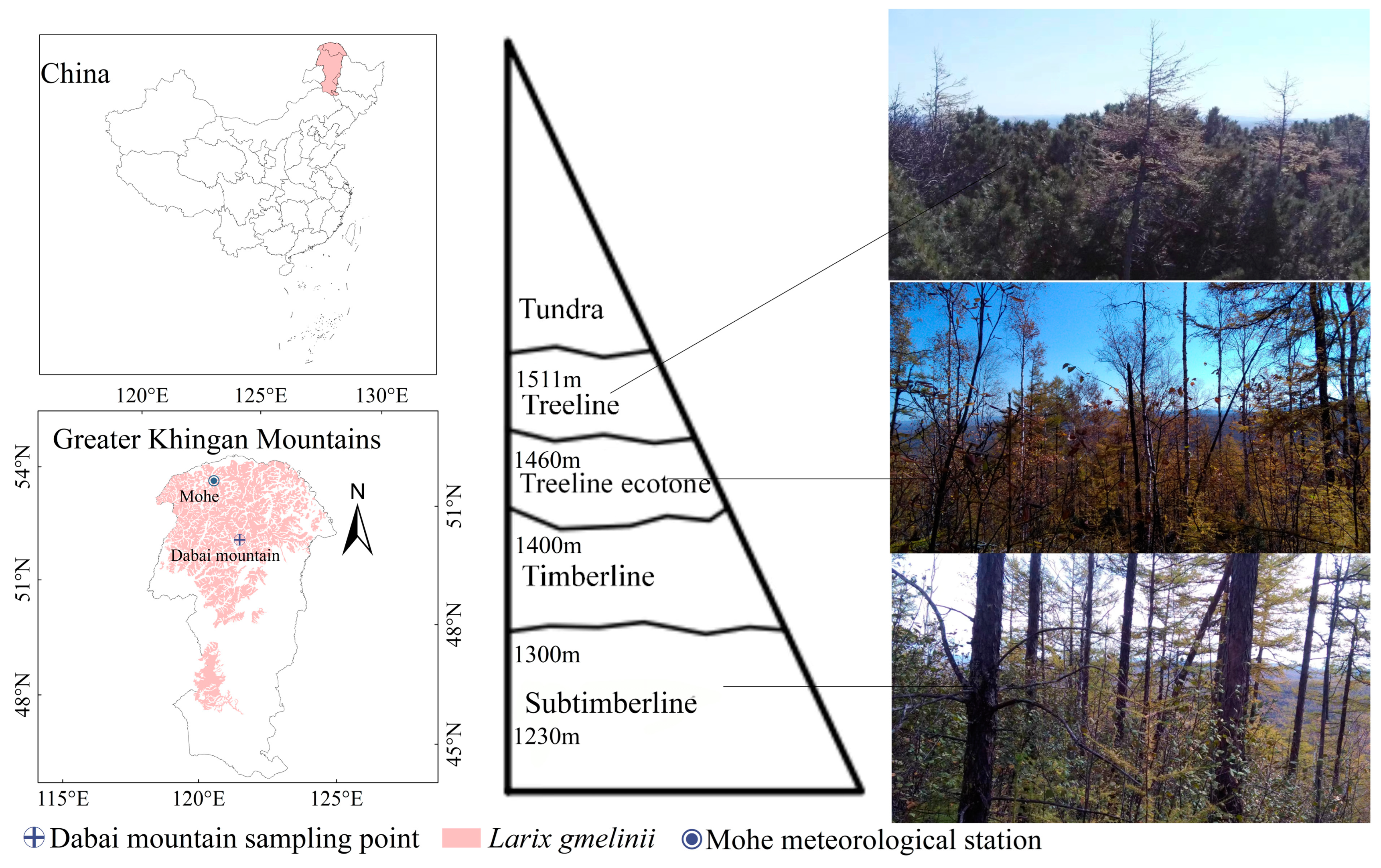
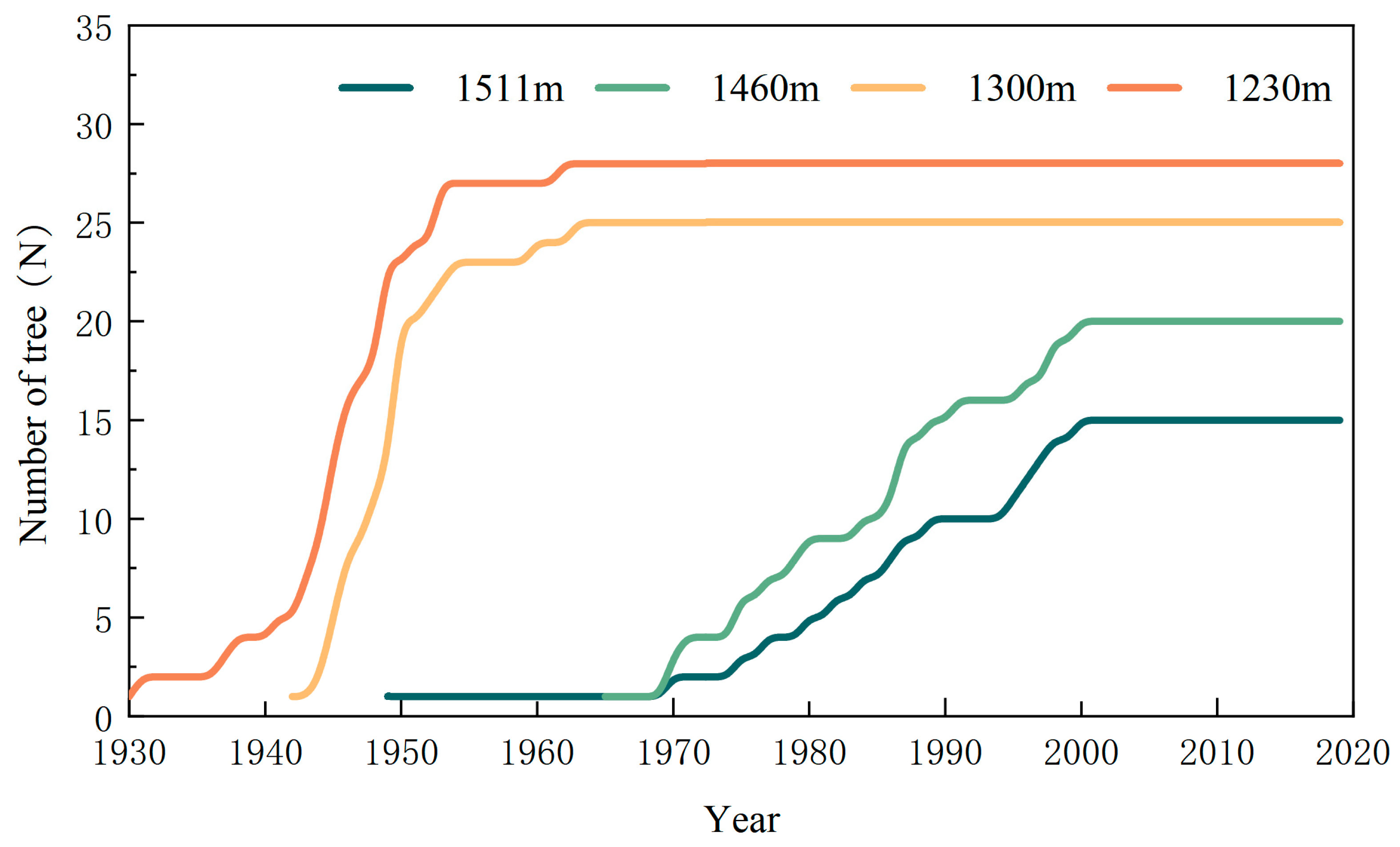
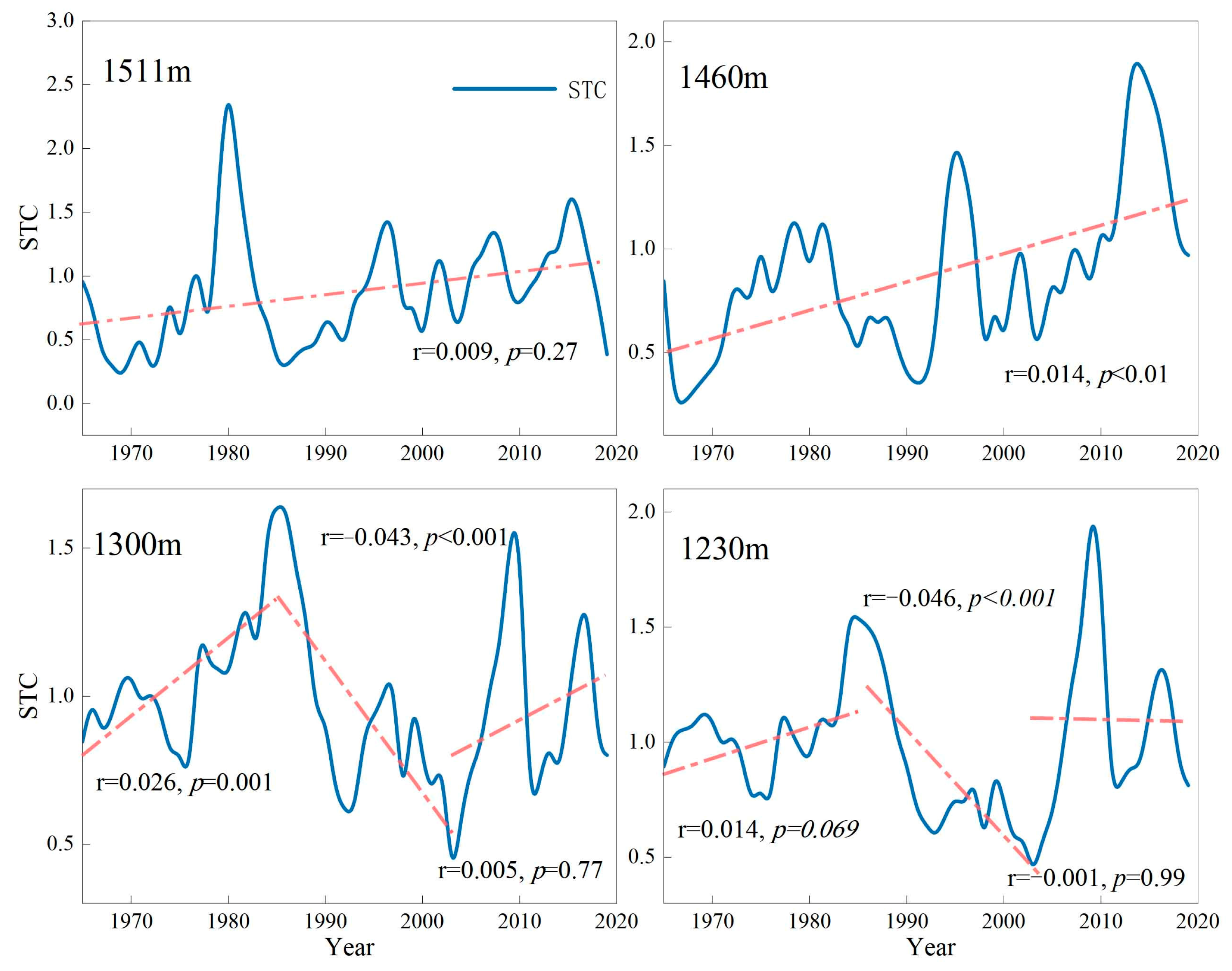
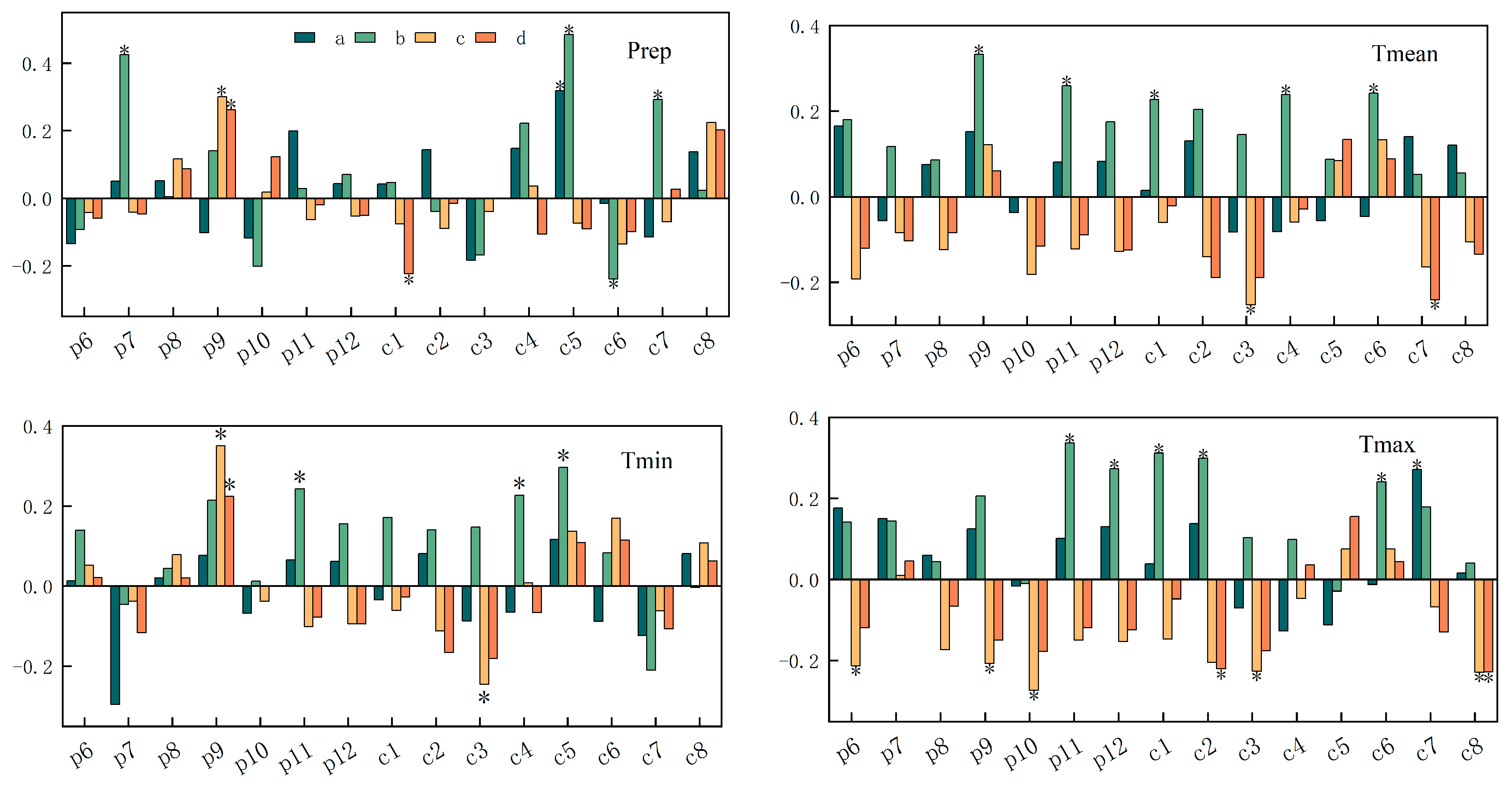
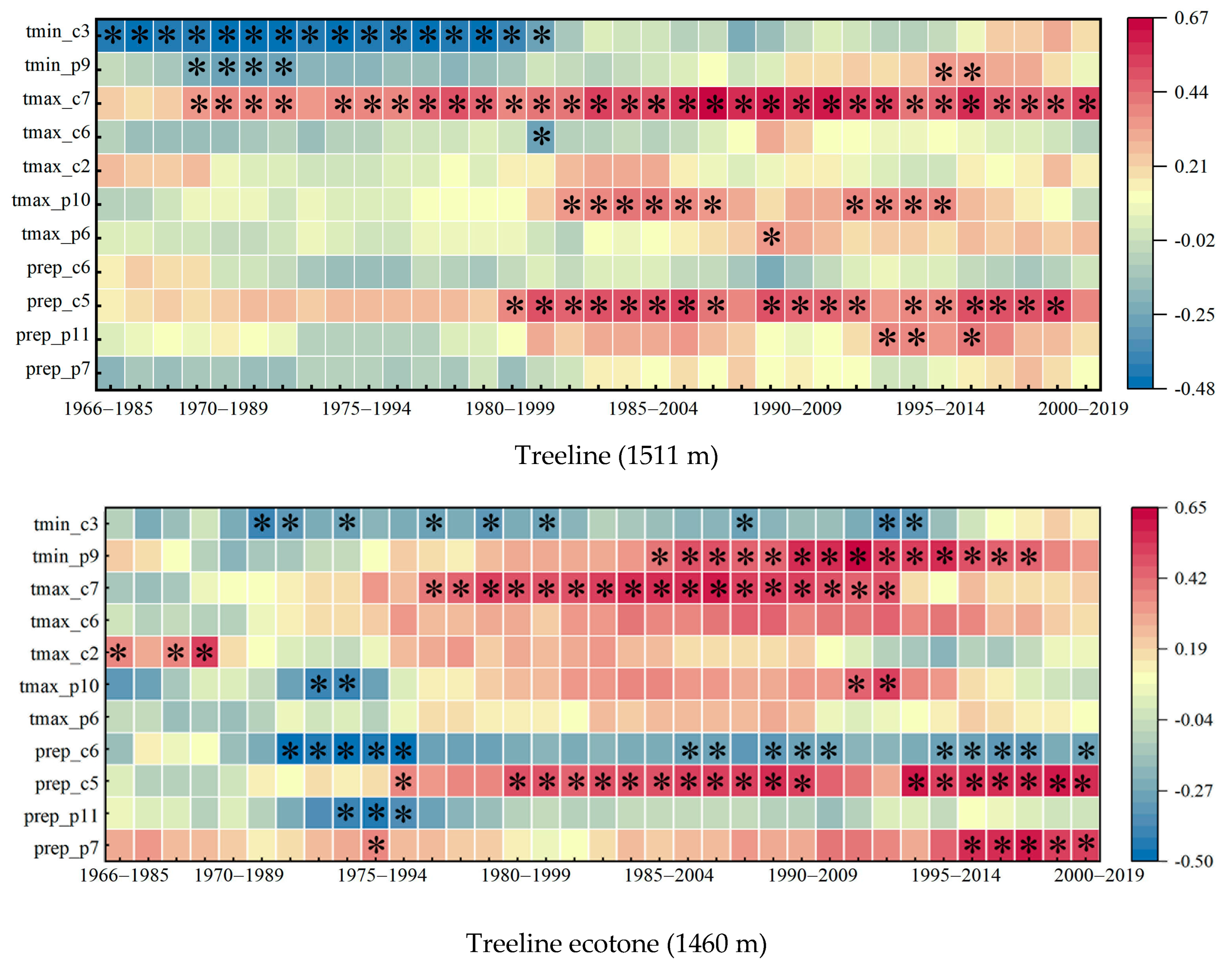
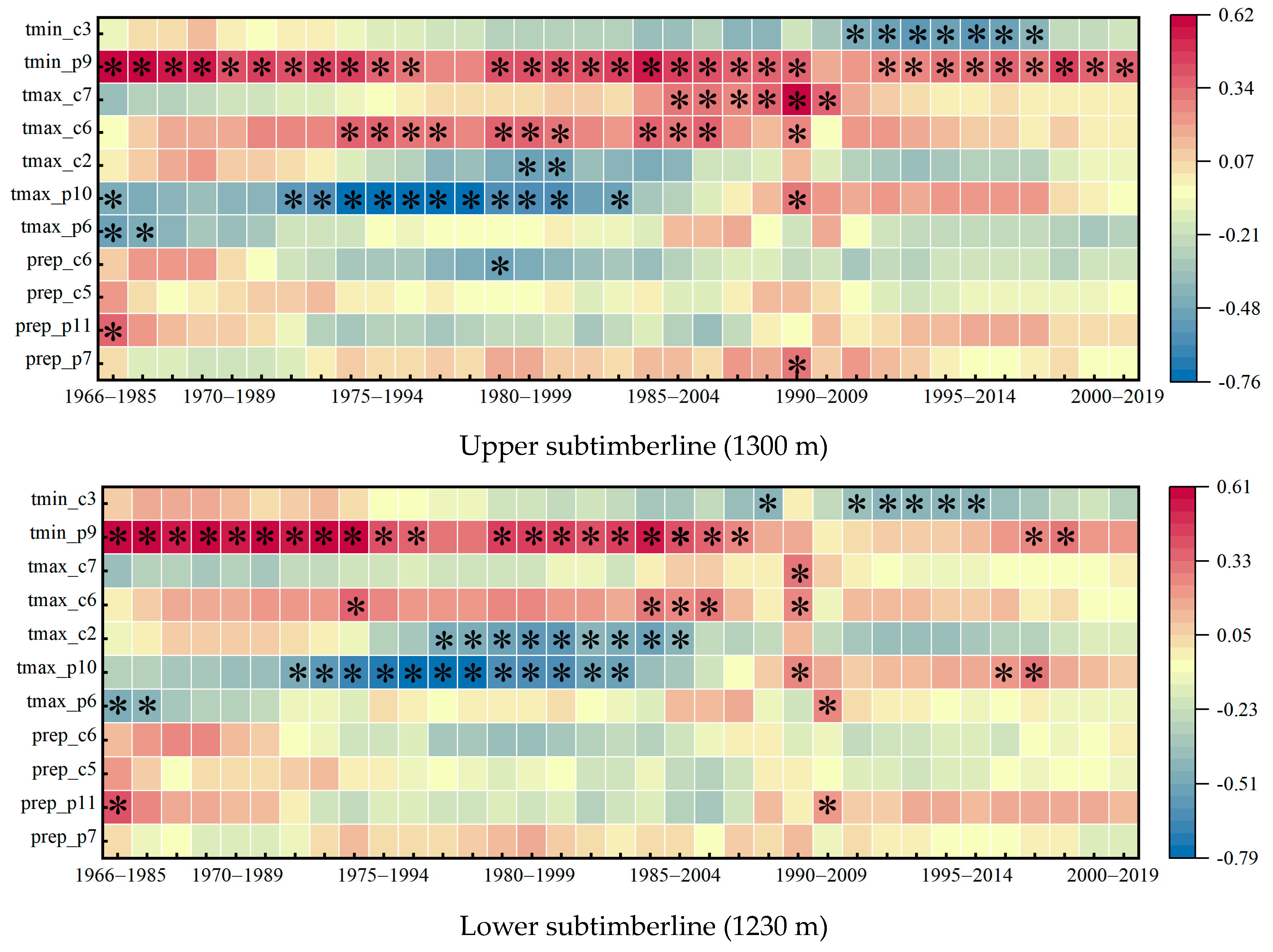
| Treeline | Treeline Ecotone | Upper Subtimberline | Lower Subtimberline | |
|---|---|---|---|---|
| Altitude (m) | 1511 | 1460 | 1300 | 1230 |
| Tree germination dates (SSS > 0.85) | 1949–2019 | 1965–2019 | 1942–2019 | 1909–2019 |
| Mean age (years) | 32 | 35 | 70 | 74 |
| Mean DBH (cm) | 4.35 (tree base) | 4.88 (tree base) | 18.56 | 17.10 |
| Mean height (m) | 1.88 (0.65–2.42) | 2.62 | 13.44 | 11.91 |
| Sample size (tree/cores) | 31/35 | 20/21 | 25/44 | 28/42 |
| Express population signal (EPS) | 0.860 | 0.912 | 0.965 | 0.974 |
| Standard deviation (SD) | 0.5137 | 0.4100 | 0.2690 | 0.3685 |
| Signal-to-noise ratio (SNR) | 6.122 | 10.367 | 27.784 | 37.317 |
| Mean sensitivity (MS) | 0.4197 | 0.2896 | 0.1868 | 0.2192 |
| Autocorrelation order 1 (AC1) | 0.5265 | 0.7467 | 0.5906 | 0.7654 |
| Mean interseries correlation (MC) | 0.338 | 0.409 | 0.416 | 0.483 |
Disclaimer/Publisher’s Note: The statements, opinions and data contained in all publications are solely those of the individual author(s) and contributor(s) and not of MDPI and/or the editor(s). MDPI and/or the editor(s) disclaim responsibility for any injury to people or property resulting from any ideas, methods, instructions or products referred to in the content. |
© 2023 by the authors. Licensee MDPI, Basel, Switzerland. This article is an open access article distributed under the terms and conditions of the Creative Commons Attribution (CC BY) license (https://creativecommons.org/licenses/by/4.0/).
Share and Cite
Li, B.; Liu, B.; Henderson, M.; Zhou, W.; Chen, M. Expansion of Treeline in North China and Its Relationship with Altitude Sensitivity Gradient of Larix gmelinii. Forests 2023, 14, 1960. https://doi.org/10.3390/f14101960
Li B, Liu B, Henderson M, Zhou W, Chen M. Expansion of Treeline in North China and Its Relationship with Altitude Sensitivity Gradient of Larix gmelinii. Forests. 2023; 14(10):1960. https://doi.org/10.3390/f14101960
Chicago/Turabian StyleLi, Bo, Binhui Liu, Mark Henderson, Wanying Zhou, and Mingyang Chen. 2023. "Expansion of Treeline in North China and Its Relationship with Altitude Sensitivity Gradient of Larix gmelinii" Forests 14, no. 10: 1960. https://doi.org/10.3390/f14101960
APA StyleLi, B., Liu, B., Henderson, M., Zhou, W., & Chen, M. (2023). Expansion of Treeline in North China and Its Relationship with Altitude Sensitivity Gradient of Larix gmelinii. Forests, 14(10), 1960. https://doi.org/10.3390/f14101960






